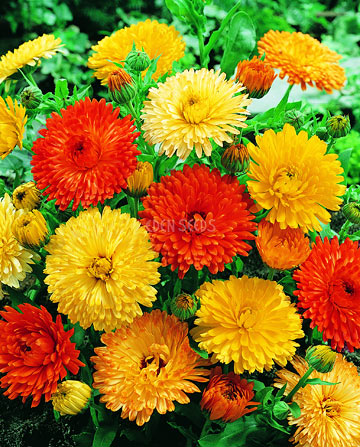Articles
Colour My World with Calendulas
By Penny Ossowski
I was brought up as a child in a garden full of colour, I guess in those days the only way most families had flowers to put in the house was to grow them and as Mum had come from a family who grew lots of flowers, vegetables and herbs it was only natural that as children our front garden was full of flowers. I remember the bright happy faces of orange calendulas growing in the garden, we used to call them marigolds then. It wasn’t until many years later when I saw Calendula Ointment that I realised they were also called Calendulas.

Calendulas give a splash of sunshine in the garden and as cut flowers they bring some sunshine into the house.
Calendula officinalis indicates by the second part of it’s name (officinalis) that it is also a very important herb. Nowadays, pot marigold, garden marigold, English Marigold and Scotch Marigold are most commonly known as Calendula which helps to distinguish it from the African and French marigolds, (tagetes genus) now commonly called marigolds. Calendula officinalis is grown for its beautiful flowers, edible petals and the many medicinal uses of its flowers, stems and leaves.
The calendula is a member of the Asteraceae or daisy family. It is native to the Mediterranean through to the Macaronesia region and some areas of the Middle East.
Although sometimes classed as a warm weather plant they dislike the extreme heat of our summers so it is better in the Southeast corner of Queensland to plant them at the end of summer. To grow Calendulas prepare a well drained garden bed with lots of organic material in full sun (they will grow in partial shade but prefer the full sun). If your garden bed is not suitable they will grow well in pots and other containers. It is a very easy plant to grow, sow seeds directly into the garden beds or if you prefer into a seed tray. Extra seedlings can be planted around the garden wherever there is a space to be filled as they will attract many beneficial insects to your garden.
Mulch plants to stop weeds and conserve moisture in the soil and in very dry weather give them some water. They will grow about 40 – 45cm high and as wide and flowers can range in colour from lemon to bright orange and even a red colour and have an almost spicy aroma. As with most flowering plants the more flowers you remove the more flowers the plant will produce but leave a few flowers to go to seed, keep some seeds for next year even though they will self seed.
Aphids like the succulent calendula but can easily be treated with a soap spray. Snails, slugs and thrips can at times cause a few problems. In rainy, hot and humid weather they can also suffer with some mildew but treat with milk or sulphur spray.
Calendula flowers can be used as cut flowers to beautify your home; alternately the petals can be used in the kitchen. The simplest way is to add them to your favourite salad or add to your stir fry, cakes, puddings, stews, rice or even soup. Did you know calendula was once known as ‘poor mans saffron’ or that an extract from them is feed to hens to make their egg yolks golden. Calendula is also used to colour butter and cheese and to flavour confectionery, soft drinks and many baked products.
The medicinal herb Calendula seed – also known as Pot Marigold - is available from Eden Seeds and Select Organic. Buy Calendula seed online.
What Herbs are in Your Garden – maybe Calendula?
Then the greatest value the Calendula has to offer is its medicinal properties. It has antiseptic, anti-viral, antibacterial, anti-genotoxic and anti-inflammatory uses.
Externally Calendula is effective for skin problems such as cuts, abrasions, sunburn, burns, acne, rashes, dermatitis, eczema, tinea, diaper rash, almost any skin disorder, boils, abscesses, remove wrinkles etc.
Internally it can be useful for constipation, abdominal pain, gastritis, peptic ulcers, recurrent vomiting, colitis, gastrointestinal problems, menstrual problems, headaches, toothaches and even tuberculosis, liver complaints, cleansing for the liver and gallbladder. Calendula flowers can be added to massage oils and salves to soften skin and also makes a great conditioner for oily hair.
In history it has been reported that
· The ancient Romans used calendula to treat scorpion bites
· Soldiers in the American Civil War found it helped stop wounds from bleeding.
· European folk medicine healers used it to induce menses, produce sweat during fevers, and to cure jaundice
· Rub a calendula flower onto a bee or wasp sting to relieve pain and reduce swelling
· Calendula can be used as creams, salves, teas and tinctures. While I don’t recommend how you use these here are some recipes you might like to try.
Calendula tea: pour a cup of boiling water over 1 to 2 teaspoons of calendula flowers, sit for 15 minutes before drinking.
Calendula tincture: soak a cup of flowers in 600mls of rectified alcohol for 5 to 6 weeks. Five to fifteen drops of this may be taken with water or tea with no more than 3 doses per day.
Calendula salve: boil 30 grams of dried flowers or leaves in 30 grams of lard for external use only
Calendula Ointment: add 2 handfuls of calendula leaves and flowers to 1tbsp lanolin, 5tbsp olive oil and 1tbsp beeswax and heat gently. Mix together; take off the heat and leave to set. The following morning re-heat the mixture and pour into a sterile jar and leave to harden.



